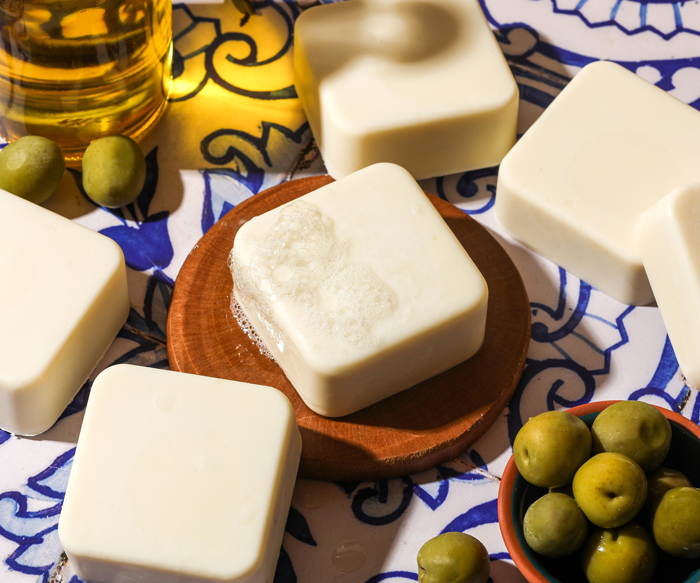What is Castile Soap?
Castile soap is a popular traditional soap that is renowned for its gentleness on the skin. Simply put, castile soap is cold process soap made with 100% olive oil. While the term ‘Castile’ has evolved through the years to sometimes include small amounts of other oils, the most traditional of Castile soaps still use only olive oil as the main ingredient.
In addition to being gentle and good for sensitive skin, castile soap is also eco-friendly and (like all handmade soap) is biodegradable. Because of the long shelf life of fully cured castile soap, castile soap products are often packaged minimally or fully naked, which helps reduce packaging waste.
The History of Castile Soap
The Castile region of Spain is where Castile soap first appeared some centuries ago. Although the exact origins of Castile soap are unclear, it is said to have originated in the Mediterranean region, specifically in the regions that make up modern-day Spain and Italy. The creation of a soap based mostly on olive oil was greatly aided by the region's profusion of the oil. Due to its efficiency, mildness, and purity, this was a popular soap style throughout Europe.

Benefits and Limitations of Castile Soap
With its straightforward and natural ingredients, castile soap has a number of advantages and only one real limitation.
Castile Benefits
- Extremely gentle - Castile soap's gentleness on the skin makes it an incredible bar of soap. People with sensitive skin, allergies, or skin disorders including psoriasis and eczema frequently use castile soap.
- Natural ingredients - Because Castile soap is made of olive oil, it is an all-natural product making it perfect for those looking for all-natural products.
- Long shelf life - Olive oil is known for its stability in soap, and long shelf life. This means less chance for your bar to go rancid or produce Dreaded Orange Spots, aka “DOS.” The lather is small and creamy with peak lathering ability developing over a full year of cure time.
Castile Limitations
- Long cure time: In order for castile soap to really shine, it needs a long shelf life. For peak lather and performance, castile soap needs to cure for 1 year. Without a proper cure time, castile soap has a slimy and dense lather.
- Effectiveness in hard water - Because of its low lathering, castile soap might not work well in hard water, which could result in the accumulation of soap scum.
- Small gentle lather - Some consumers may associate large bubbles with cleansing ability (which is not accurate) and may not appreciate the smaller, gentle lather of castile soap.
Curing Castile Soap
In order to experience castile soap at its very best, it needs a long cure time. Peak lathering ability develops over a full year of cure time. Although castile soap is ready to use within 4 to 6 weeks like any cold-process soap, the lather might be a little dense and slimy for several months.
This is often why soapmakers like to introduce small percentages of other oils like coconut oil or castor oil - to help increase lather. But ask 10 soapers how long castile soap needs to cure, and you’ll probably get 10 different answers! One year is the most common, and we think it’s the sweet spot.
Some soap makers discount the water in their recipe, and find that helps cut down the cure time. Others like to hot process their castile soap, which can cut down on cure time as well. If you want to find the ideal cure time for you, the only real way is to make a batch and test the bars at various intervals.
Castile Soap vs. Bastille Soap
You may have also heard of the term “Bastille Soap.” Bastille is typically used to refer to a soap that has a very high portion of olive oil, with a few other oils added to balance the bar. Usually, a bastille soap has about 70-90% olive oil, with oils such as coconut, palm, or castor making up the remainder of the formula.
Unlike Castile soap, which has a historical geographical background, "Bastille" is more of a recent nomenclature used by soap makers to refer to this mostly olive oil soap. Because of the high olive oil content, it’s still extremely gentle and great for sensitive skin. The addition of different oils will affect the soap firmness and lather. Take a look at the recipes below to see the difference between castile and bastile.
Example Castile Soap Recipe
- 16 oz. olive oil (100%)
- 2.1 oz. sodium hydroxide
- 4.7 oz. distilled water
Example Bastille Soap Recipe
- 14 oz. olive oil (90%)
- 0.8 oz. coconut oil (5%)
- 0.8 oz. palm oil (5%)
- 2.1 oz. sodium hydroxide
- 4.7 oz. distilled water
Get Started Making Castile Soap
Castile soap is a great beginner soap, is eco-friendly, and makes a fantastic gentle-skin soap for babies, sensitive skin and everyday use. Checkout the castile recipes below to get started!
Classic Castile Soap
It doesn't get any more classic than this recipe! Made with 100% pure olive oil, this project does not contain any colorants or fragrance. It creates an extremely gentle bar, and the square shape means no cutting into bars. This is the perfect recipe for beginners - just make sure to give it a proper cure to avoid a slimy lather.
Swirl Buttermilk Castile Soap
This recipe is perfect when you're ready to take the next step into castile with additives! The addition of buttermilk adds lactic acid, which is wonderful for the skin. The colorant comes from dried madder root, a climbing plant with pale yellow flowers. The lavender-and-peppermint essential oil blend smells amazing. The soap is designed with an in-the-pot swirl and finished with beveled edges.
